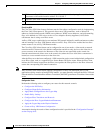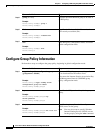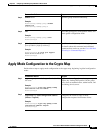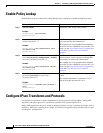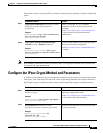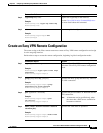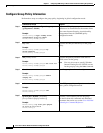
6-10
Cisco Secure Router 520 Series Software Configuration Guide
OL-14210-01
Chapter 6 Configuring a VPN Using Easy VPN and an IPsec Tunnel
Verifying Your Easy VPN Configuration
Verifying Your Easy VPN Configuration
router# show crypto ipsec client ezvpn
Tunnel name :ezvpnclient
Inside interface list:vlan 1
Outside interface:fastethernet 4
Current State:IPSEC_ACTIVE
Last Event:SOCKET_UP
Address:8.0.0.5
Mask:255.255.255.255
Default Domain:cisco.com
Configuration Example
The following configuration example shows a portion of the configuration file for the VPN
and IPsec tunnel described in this chapter.
!
aaa new-model
!
aaa authentication login rtr-remote local
aaa authorization network rtr-remote local
aaa session-id common
!
Step 5
exit
Example:
Router(config-crypto-ezvpn)# exit
Router(config)#
Returns to global configuration mode.
Step 6
interface type number
Example:
Router(config)# interface fastethernet 4
Router(config-if)#
Enters the interface configuration mode for the
interface to which you want the Cisco Easy VPN
remote configuration applied.
Note For routers with an ATM WAN interface,
this command would be interface atm 0.
Step 7
crypto ipsec client ezvpn name [outside | inside]
Example:
Router(config-if)# crypto ipsec client
ezvpn ezvpnclient outside
Router(config-if)#
Assigns the Cisco Easy VPN remote configuration
to the WAN interface, causing the router to
automatically create the NAT or port address
translation (PAT) and access list configuration
needed for the VPN connection.
Step 8
exit
Example:
Router(config-crypto-ezvpn)# exit
Router(config)#
Returns to global configuration mode.
Command or Action Purpose



